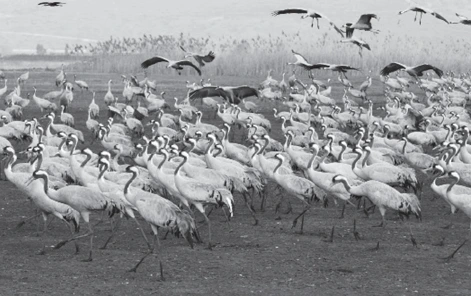Public Policy Review

I am taking my first-ever sabbatical this Spring semester. My travels and fact-finding will include lectures in Israel and Australia about water policy under conditions of growth and scarcity. I expect to speak about transboundary aquifer assessment and water banking at the Sixth World Water Forum in Marseille, France. I consider myself lucky to have the opportunity to share our region’s water management innovations, along with our challenges. Sharing experiences and lessons learned is very important for identifying pathways to meeting water management goals. Identifying commonalities actually makes the world seem smaller and gives me the sense that, although many water issues are local or regional, we truly are in this together.
In November 2011, this view was reinforced by my visits to water sites in the Middle East and Mexico. In Israel, I spent two days visiting projects sponsored by the Jewish National Fund of the United States (JNF-USA). Located in the city of Be’er Sheva in the Negev desert, the Be’er Sheva River Park started in the 1990s as a river restoration project. It has grown into a massive water, environment and economic development project, which is transforming the riverfront into the largest municipal park in the country. The ongoing work reminded me of the river restoration sites in Phoenix and Tucson. In fact, in November 2010 I met Itai Freeman, director of this large-scale project, when he spoke of this project and I spoke about successful restoration in central Phoenix. It was gratifying and informative to see the on-the-ground progress they’ve made in just one short year. I also visited two school-sites, one on a kibbutz and one in Jerusalem, designed by Amir Yechieli, where toilets are being flushed with rainwater collected on site. I saw well drilling activity in Northern Israel, where a new well field will provide supplemental watering of tree orchards when surface water supplies are insufficient. Nearby, I saw the site of a devastating 2010 forest fire. In Jordan, I visited the site in the Jordan Valley, Deir Alla, where grey water is expected to be collected from homes, treated with a specially designed filter, and delivered to nearby farms. The Jordan Valley Authority provides blended wastewater to the Jordan Valley, the largest agricultural region in Jordan. The site for the grey water facility lacks public sewage services, and freshwater supply from the municipal network is limited. The filter, designed by the Jordanian Royal Scientific Society team with whom I’ve had the pleasure of working, employs a simple low-cost technology suitable for use by local residents and farmers.
A coincidence of timing had me visiting two water bodies,thousands of miles apart, that serve as flyways for many bird species, one in Israel, the other in Mexico. The first was Agamon Ha’Hula, the “little lake” in the Hula Valley in the northern part of Israel. This successful restoration project, funded by Keren Kayemet L’Israel - Jewish National Fund (KKL-JNF), involved restoring water to an area that was previously drained to increase arable land. The results of the drainage were so severe that, over time, spontaneous underground combustion resulted. The restored area involves a small lake that now attracts many bird species, including migrating euro-asian cranes. At dusk, they swoop into the lake area to sleep for the evening. What a sight to see – and sounds to hear. The little lake is a focal point for eco-tourism and outdoor recreation, with trails established for bicyclists, and motorized tours enable visitors like me to see the splendor of the migrating cranes. The thought that came to mind is a variant of “if you build it, they will come,” namely, “if there is water, the birds will come.”
In late November, I had the honor of being hosted by the Mexican Commissioner of the International Boundary and Water Commission Roberto Salmón Castelo and accompanied by U.S. IBWC Commissioner Edward Drusina for a visit to the Cienega de Santa Clara. On our way to the Cienega, another important flyway, we visited a Mexicali wastewater treatment plant and adjacent wetlands site. It is expected that the additional treatment provided by the wetlands will produce water suitable for reuse. The development of the wetlands, still under construction, is being steered by the Sonoran Institute and Pro Natura. Both nongovernmental organizations had expert staff on hand with us for the day. We crossed a bridge over the Rio Colorado, where the water in the river is agricultural return flows. We lunched at a riparian restoration site, which has received Mexican federal governmental funding to provide shortterm employment. Then we arrived at the Cienega and boarded small boats. We saw wonderful bird habitat. It was inspiring to see this site, about which I had heard so much. The Cienega has significance to the issue of operating the Yuma Desalting Plant – the water that would be directed to the YDP for treatment currently flows into the Cienega. An important part of the recent YDP test run was a historic binational agreement to send additional water to the Cienega in order to mitigate impacts to this wetland, along with an environmental monitoring program implemented by a team of US and Mexican scientists. A monitoring report is expected soon.
Visiting Agamon Ha’Hula, the Cienega de Santa Clara, and the several other sites reinforced the importance of seeing things with one’s own eyes and exchanging information and lessons learned. The connections to our region are obvious: river restoration, rainwater harvesting, grey water filtration, water for people and agriculture, drought and fire. These projects also underscore the crucial roles of public-private partnerships and dedication to finding solutions to difficult water challenges. I look forward to sharing my sabbatical experiences in future columns!

